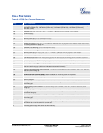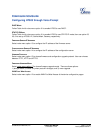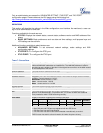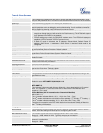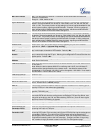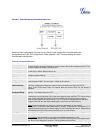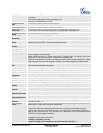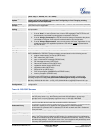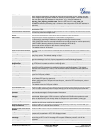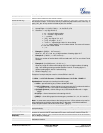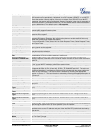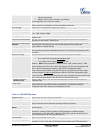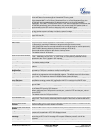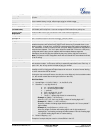
Grandstream Networks, Inc. HT503 User Manual Page 24 of 38
Firmware 1.0.4.2 Last Updated: 06/2011
(Note: freq: 0 - 4000Hz; vol: -30 - 0dBm)
Lock Keypad
Update
If set to “Yes”, the configuration update via keypad is disabled. Note: some informative
options still will be available for users after configuring to Yes. Changing existing
configuration will be impossible.
Disable Voice
Prompt
Disables the voice prompt configuration. Default is “No. ” If set to “Yes” accessing integrated
voice menu will be impossible.
Disable Direct IP
Calling
Disables the Direct IP Call function. Default is “No.” ” If set to “Yes” to make direct IP call will
be impossible.
Life Line Mode
Life line feature ensures user can place/receive a PSTN call in an emergency situation.
1. If set to “Auto”, in case of power loss or loss of SIP registration, the PSTN line will
be seamlessly connected to analog phone connected to FXS port.
2. If set to “Always Connected” the PSTN line will be always connected to the phone
connected to FXS port. VoIP calls will not be allowed in this configuration.
3. If set to “Always Disconnected”, user can only place VoIP calls, regardless of any
power loss and/or SIP registration problems. User will be unable to place/receive
any PSTN calls.
NTP serve
r
URL or IP address of the NTP server, Used to synchronize the date/time.
Syslog Serve
r
The IP address or URL of syslog server, especially useful for ITSP
Syslog Level
Select the ATA to report the log level. Default is NONE. The level is either one of DEBUG,
INFO, WARNING or ERROR. Syslog messages are sent based on the following events:
• product model/version on boot up (INFO level)
• NAT related info (INFO level)
• sent or received SIP message (DEBUG level)
• SIP message summary (INFO level)
• inbound and outbound calls (INFO level)
• registration status change (INFO level)
• negotiated codec (INFO level)
• Ethernet link up (INFO level)
• SLIC chip exception (WARNING and ERROR levels)
• memory exception (ERROR level)
The Syslog uses USER facility. In addition to standard Syslog payload, it contains the
following components: GS_LOG: [device MAC address][error code] error message
Ex. May 19 02:40:38 192.168.1.14 GS_LOG: [00:0b:82:00:a1:be][000] Ethernet link is up
Download Device
Configuration
This is a special feature that enables the user to create a text file backup of your existing
configuration.
T
ABLE 10: FXS PORT SETTINGS
Account Active
When set to yes the FXS port is activated.
SIP Serve
r
This field contains the URL string or the IP address (and port, if different from 5060) of
the SIP proxy server. e.g., the following are some valid examples: sip.my-voip-
provider.com, or sip:my-company-sip-server.com, or 192.168.1.200:5066
Failover SIP Serve
r
This Field contains the URL or the IP address of a second SIP server, this one will be
used in case the device looses the connection with the first server.
Outbound Proxy
IP address or Domain name of Outbound Proxy, or Media Gateway, or Session Border
Controller. Used by ATA for firewall or NAT penetration in different network
environment. If symmetric NAT is detected, STUN will not work and ONLY Outbound
Proxy will work.
SIP Transport
User can select UDP or TCP or TLS.
NAT Traversal (STUN)
This setting decides whether the NAT traversal mechanism is activated. It should be
set to “Yes” if the device is behind a NAT router. If no outbound proxy is configured, a
STUN server needs to be set to activate STUN detection mechanism. Usually ITSP will
provide these settings. If this field is set to “Yes”, then the device will periodically send
a dummy UDP packet to the SIP server to pinhole the NAT.



